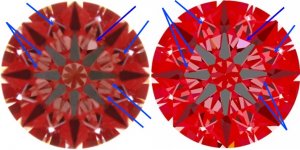Shay37
Ideal_Rock
- Joined
- Mar 1, 2004
- Messages
- 3,343
Clever, Marty. Thus the inference of actual only if the measuring device is indeed accurate. Considering the headache after following sort of thus far, difficult to ascertain if the measuring device is accurate, and therein lies the crux.Date: 1/26/2007 5:59:37 PM
Author: adamasgem
It is my understanding that the scanners use the stepped pedestal to calibrate the system.Date: 1/26/2007 5:27:56 PM
Author: Rhino
Answer: Yes. The proper wording IMO would be 'They are the actual average crown angles.'Date: 1/26/2007 5:16:33 PM
Author: strmrdr
You know something about my answer bugged me and after thinking about it...
Can average angles of 8 facets ever be considered true or actual?
None of the facets may actualy have that specific number.
It might be interesting to check the scanners linear calibration using square steel guage blocks, which can be obtained for $25 bucks or so in 1/4 inch sizes with linear tolerances +/- 0.000005 inches 0r equivilently +/- 0.000125mm
A small right angle optical prism to check angle accuracy or consistency might also prove informative, as one can flip it..
Of course the apriori model the scanner is trying to solve for would have to be changed. I don't know how difficult that would be. Have to check with Sarin on that, or maybe Serg could comment..
PS I would avoid the use of the word 'actual' and replace it with 'measured'
shay
edited for clarity









300x240.png)